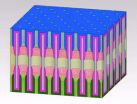(Press-News.org) Researchers from the Norwegian University of Science and Technology (NTNU) and the University of Cambridge in the UK have demonstrated that it is possible to directly generate an electric current in a magnetic material by rotating its magnetization.
The findings reveal a novel link between magnetism and electricity, and may have applications in electronics.
The electric current generation demonstrated by the researchers is called charge pumping. Charge pumping provides a source of very high frequency alternating electric currents, and its magnitude and external magnetic field dependency can be used to detect magnetic information.
The findings may, therefore, offer new and exciting ways of transferring and manipulating data in electronic devices based on spintronics, a technology that uses electron spin as the foundation for information storage and manipulation.
The research findings are published as an Advance Online Publication (AOP) on Nature Nanotechnology's website on 10 November 2014.
Spintronics has already been exploited in magnetic mass data storage since the discovery of the giant magnetoresistance (GMR) effect in 1988. For their contribution to physics, the discoverers of GMR were awarded the Nobel Prize in 2007.
The basis of spintronics is the storage of information in the magnetic configuration of ferromagnets and the read-out via spin-dependent transport mechanisms.
"Much of the progress in spintronics has resulted from exploiting the coupling between the electron spin and its orbital motion, but our understanding of these interactions is still immature. We need to know more so that we can fully explore and exploit these forces," says Arne Brataas, professor at NTNU and the corresponding author for the paper.
An electron has a spin, a seemingly internal rotation, in addition to an electric charge. The spin can be up or down, representing clockwise and counterclockwise rotations.
Pure spin currents are charge currents in opposite directions for the two spin components in the material.
It has been known for some time that rotating the magnetization in a magnetic material can generate pure spin currents in adjacent conductors.
However, pure spin currents cannot be conventionally detected by a voltmeter because of the cancellation of the associated charge flow in the same direction.
A secondary spin-charge conversion element is then necessary, such as another ferromagnet or a strong spin-orbit interaction, which causes a spin Hall effect.
Brataas and his collaborators have demonstrated that in a small class of ferromagnetic materials, the spin-charge conversion occurs in the materials themselves.
The spin currents created in the materials are thus directly converted to charge currents via the spin-orbit interaction.
In other words, the ferromagnets function intrinsically as generators of alternating currents driven by the rotating magnetization.
"The phenomenon is a result of a direct link between electricity and magnetism. It allows for the possibility of new nano-scale detection techniques of magnetic information and for the generation of very high-frequency alternating currents," Brataas says.
The generation and modulation of high-frequency currents are central wireless communication devices such as mobile phones, WLAN modules for personal computers, Bluetooth devices and future vehicle radars.
INFORMATION:
The research team also included scientists from the University of Copenhagen; the Institute of Physics ACSR, Czech Republic; the University of California, Los Angeles; and the Japan Science and Technology Agency.
LA JOLLA, CA--November 10, 2014--Chemists at The Scripps Research Institute (TSRI) and the Shanghai Institute of Organic Chemistry have described a method for creating and modifying organic compounds that overcomes a major limitation of previous methods. The advance opens up a large number of novel chemical structures for synthesis and evaluation, for example, as candidate pharmaceuticals.
The new method was designed to avoid an unwanted side effect--a diversion of a catalyst molecule to the wrong location--that prevents chemists from manipulating many organic compounds ...
The Southern Ocean plays an important role in the exchange of carbon dioxide between the atmosphere and the ocean. One aspect of this is the growth of phytoplankton, which acts as a natural sponge for carbon dioxide, drawing the troublesome greenhouse gas from the atmosphere into the sea. When these plankton die they can sink to the bottom of the ocean and store some of the carbon dioxide they have absorbed, a process scientists call the "biological carbon pump".
Although many areas of the Southern Ocean are rich in nutrients, they often lack iron, which limits phytoplankton ...
Cold Spring Harbor, NY - Think about all the things you are doing at this moment. As your eyes scan across the lines of this article, maybe your brain is processing the smell of coffee brewing down the hall and the sound of leaf blowers outside your window. Maybe you are tapping your foot and spinning a pen between your fingers. At any given moment, your brain is simultaneously processing a multitude of information from your senses while supporting a dizzying array of behaviors.
How is all this information processed at once? The provisional answer, for decades, has centered ...
COLLEGE PARK, Md. -- Researchers at the University of Maryland have invented a single tiny structure that includes all the components of a battery that they say could bring about the ultimate miniaturization of energy storage components.
The structure is called a nanopore: a tiny hole in a ceramic sheet that holds electrolyte to carry the electrical charge between nanotube electrodes at either end. The existing device is a test, but the bitsy battery performs well. First author Chanyuan Liu, a graduate student in materials science & engineering, says that it can be ...
OAK RIDGE, Tenn., Nov. 10, 2014--For more than 50 years, scientists have debated what turns particular oxide insulators, in which electrons barely move, into metals, in which electrons flow freely. Some scientists sided with Nobel Prize-winning physicist Nevill Mott in thinking direct interactions between electrons were the key. Others believed, as did physicist Rudolf Peierls, that atomic vibrations and distortions trumped all. Now, a team led by the Department of Energy's Oak Ridge National Laboratory has made an important advancement in understanding a classic transition-metal ...
Cold Spring Harbor, NY - There are roughly 20,000 genes and thousands of other regulatory "elements" stored within the three billion letters of the human genome. Genes encode information that is used to create proteins, while other genomic elements help regulate the activation of genes, among other tasks. Somehow all of this coded information within our DNA needs to be read by complex molecular machinery and transcribed into messages that can be used by our cells.
Usually, reading a gene is thought to be a lot like reading a sentence. The reading machinery is guided ...
Thousands of never-before-seen genetic variants in the human genome have been uncovered using a new genome sequencing technology. These discoveries close many human genome mapping gaps that have long resisted sequencing.
The technique, called single-molecule, real-time DNA sequencing (SMRT), may now make it possible for researchers to identify potential genetic mutations behind many conditions whose genetic causes have long eluded scientists, said Evan Eichler, professor of genome sciences at the University of Washington, who led the team that conducted the study.
"We ...
UCLA neuroscientists discovered that statins, a popular class of cholesterol drugs, reverse the learning deficits caused by a mutation linked to a common genetic cause of learning disabilities. Published in the Nov. 10 advance online edition of Nature Neuroscience, the findings were studied in mice genetically engineered to develop the disease, called Noonan syndrome.
The disorder can disrupt a child's development in many ways, often causing unusual facial features, short stature, heart defects and developmental delays. No treatment is currently available.
"Noonan ...
Thanks to research performed at RIKEN's SACLA x-ray free electron laser facility in Japan, the dream of analyzing the structure of large, hard-to-crystallize proteins and other bio molecules has come one step closer to reality. In the study published in Nature Methods, researchers used a newly developed grease to suspend small crystals of lysozyme, glucose isomerase, thaumatin, and fatty acid-binding protein type-3, which they then analyzed using the revolutionary serial femtosecond crystallography method.
Crystallography, which was first performed just a century ago, ...
A team of engineers and scientists has identified a source of electronic noise that could affect the functioning of instruments operating at very low temperatures, such as devices used in radio telescopes and advanced physics experiments.
The findings, detailed in the November 10 issue of the journal Nature Materials, could have implications for the future design of transistors and other electronic components.
The electronic noise the team identified is related to the temperature of the electrons in a given device, which in turn is governed by heat transfer due to packets ...







